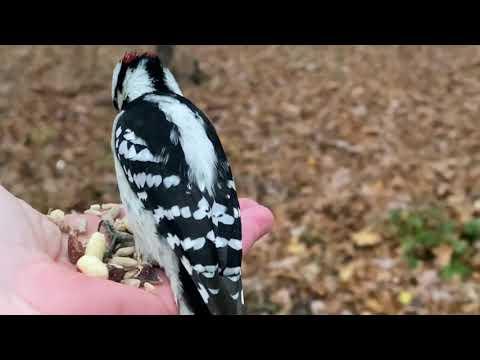Description
Chickadees have some pretty incredible abilities these charming birds have. Good things come in small packages.
54 Days Inside a Black-capped Chickadee Nest Box
https://youtu.be/RIm0a_ulCfE
Chickadees are one of the most fun birds to watch, and thanks to the fact that they live close to humans, and have a super curious way they make for easy birds to observe. Always in constant motion, these active birds can barely sit still for a moment. Their high energy demands have them searching for insects and seeds to eat from sun up to sun down, even more so in winter. As they hunt and forage there seem to be no limits to the angles they can climb and hang on. You may see one clinging on sideways as it pecks into a branch, clutched onto the trunk of a tree, hopping up a limb, or more impressively hanging upside down on a berry as it eats it. This ability to hang upside down is due to their strong, long legs. This feeding behavior is no doubt adorable to us as we watch, but for them, a very great and practical way to get at hard-to-reach food sources, such as berries or buds at the ends of twigs.
One fun thing about these tiny acrobats is the fact that they hide food away in the trees for later feeding, an interesting behavior, known as food caching. Every summer chickadees get busy preparing for the leaner times of winter by hoarding thousands of insects and seeds into the trees throughout their territory. That is a lot of hidden food to remember, and they can recall each of these for at least a month which is incredible, but just how do they do it? Well, there are a couple of things, firstly Chickadees recall their caches by using spatial organization. This type of memory involves learning and remembering one's previous experiences in its environment. Visuospatial cues such as the arrangement of trees and other items help Chickadees remember the precise location of their cache sites.
Another fascinating thing is that the part of their brain responsible for memory, the hippocampus, expands in volume by as much as 30 percent in late summer. This increase of new nerve cells allows them enough storage space for information on all that stored food. In Spring, when they don’t need this anymore, it shrinks back to its normal size.
Probably the most amazing thing that chickadees can do, as if the other things aren’t amazing enough, is the ability to lower their daytime body temperature of 42C down to around 20-30C at night. This nifty trick comes in handy for chickadees at higher elevations and latitudes who experience really short cold days over the winter season. With food scarce and daylight minimal, it is a challenge for small endothermic birds like chickadees to find and eat enough in order to not starve or freeze to death. They can only gain as much as 10 percent of their body weight in fat each day. On mild winter nights, this is plenty to sustain their energy demands as they shiver to stay warm. When temperatures fall far below 0 though, they cannot survive on their fat stores without some help. In order to get the most out of their energy reserves, a reduction in metabolism is required, which is achieved by reducing their body temperature as much as possible, anywhere between 10-20 degrees, therefore minimizing heat loss and saving on energy. This combination of shivering and a reduced metabolism is a torpor-like state called regulated Hypothermia.
Capable of laying as many as 12 eggs, chickadees sure have their work cut out for them. The ability of these birds to be such attentive hard-working parents is heart-touching. The combined effort of the mother brooding the young and the male constantly looking for food to bring back to the nest, ensure that the needs of their babies are met.
In some years, if there is bumper crop of their favorite insects, chickadees will try for a second brood after the first one has fledged. What a mama! The fact that they can have a second one, provided the conditions are right, is pretty remarkable, to say the least. Hard-working Parents.
Chapters:
00:00 Intro
00:16 Chickadees are very acrobatic birds
01:11 Chickadee food caching behavior
02:11 Chickadees can expand and shrink their brain
02:40 Chickadees can lower their body temperature
04:07 Chickadees are very hard-working parents
---

























